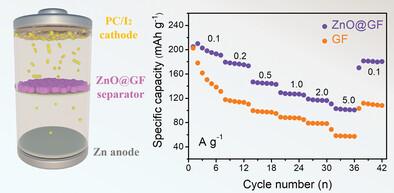Polar-Nonpolar Synergy Toward High-Performance Aqueous Zinc–Iodine Batteries
IF 13
2区 材料科学
Q1 CHEMISTRY, MULTIDISCIPLINARY
引用次数: 0
Abstract
Aqueous zinc-iodine batteries (AZIBs) hold great promise for large-scale energy storage due to their inherent safety, cost-effectiveness, and environmental sustainability. However, their practical application is hindered by the sluggish redox kinetics of iodine species and the “shuttle effect” of polyiodides, both of which degrade cycling stability and capacity retention. Herein, a “polar-nonpolar strategy” is proposed for the first time, which couples nonpolar porous carbon (PC) as the iodine host with highly polar zinc oxide (ZnO) as separator modification materials. Specifically, the PC host leverages its porous structure and nonpolar properties to accommodate and immobilize iodine, simultaneously enhancing the conductivity of the cathode. Meanwhile, the polar ZnO on the separator accelerates electron transfer with polyiodides through strong adsorption and catalytic effects, improving the reversible transformation of iodine species. UV–visible spectroscopy and electrochemical kinetic analyses confirm the rapid transformation and effective polyiodide inhibition in this system. As a result, the prepared PC-I2//ZnO@GF battery demonstrates high-rate capacity and excellent long-term cycling stability, surpassing the performance of other recently reported AZIBs. This polar-nonpolar strategy establishes a novel design rationale for developing future high-performance zinc-iodine batteries.

求助全文
约1分钟内获得全文
求助全文
来源期刊

Small
工程技术-材料科学:综合
CiteScore
17.70
自引率
3.80%
发文量
1830
审稿时长
2.1 months
期刊介绍:
Small serves as an exceptional platform for both experimental and theoretical studies in fundamental and applied interdisciplinary research at the nano- and microscale. The journal offers a compelling mix of peer-reviewed Research Articles, Reviews, Perspectives, and Comments.
With a remarkable 2022 Journal Impact Factor of 13.3 (Journal Citation Reports from Clarivate Analytics, 2023), Small remains among the top multidisciplinary journals, covering a wide range of topics at the interface of materials science, chemistry, physics, engineering, medicine, and biology.
Small's readership includes biochemists, biologists, biomedical scientists, chemists, engineers, information technologists, materials scientists, physicists, and theoreticians alike.
 求助内容:
求助内容: 应助结果提醒方式:
应助结果提醒方式:


